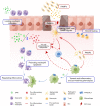Formyl peptide receptor 2 as a potential therapeutic target for inflammatory bowel disease
- PMID: 35840658
- PMCID: PMC9812994
- DOI: 10.1038/s41401-022-00944-0
Formyl peptide receptor 2 as a potential therapeutic target for inflammatory bowel disease
Abstract
Inflammatory bowel disease (IBD) is a global health burden whose existing treatment is largely dependent on anti-inflammatory agents. Despite showing some therapeutic actions, their clinical efficacy and adverse events are unacceptable. Resolution as an active and orchestrated phase of inflammation involves improper inflammatory response with three key triggers, specialized pro-resolving mediators (SPMs), neutrophils and phagocyte efferocytosis. The formyl peptide receptor 2 (FPR2/ALX) is a human G protein-coupled receptor capable of binding SPMs and participates in the resolution process. This receptor has been implicated in several inflammatory diseases and its association with mouse model of IBD was established in some resolution-related studies. Here, we give an overview of three reported FPR2/ALX agonists highlighting their respective roles in pro-resolving strategies.
Keywords: FPR2/ALX; IBD; SPM; inflammation; pro-resolving; resolution.
© 2022. The Author(s), under exclusive licence to Shanghai Institute of Materia Medica, Chinese Academy of Sciences and Chinese Pharmacological Society.
Conflict of interest statement
The authors declare no competing interests.
Figures



Similar articles
-
Recent advances in the design and development of formyl peptide receptor 2 (FPR2/ALX) agonists as pro-resolving agents with diverse therapeutic potential.Eur J Med Chem. 2021 Mar 5;213:113167. doi: 10.1016/j.ejmech.2021.113167. Epub 2021 Jan 12. Eur J Med Chem. 2021. PMID: 33486199 Review.
-
Treating neutrophilic inflammation in COPD by targeting ALX/FPR2 resolution pathways.Pharmacol Ther. 2013 Dec;140(3):280-9. doi: 10.1016/j.pharmthera.2013.07.007. Epub 2013 Jul 21. Pharmacol Ther. 2013. PMID: 23880288 Review.
-
Lack of resolution sensor drives age-related cardiometabolic and cardiorenal defects and impedes inflammation-resolution in heart failure.Mol Metab. 2020 Jan;31:138-149. doi: 10.1016/j.molmet.2019.10.008. Epub 2019 Nov 16. Mol Metab. 2020. PMID: 31918915 Free PMC article.
-
Pro-resolving mediators promote resolution in a human skin model of UV-killed Escherichia coli-driven acute inflammation.JCI Insight. 2018 Mar 22;3(6):e94463. doi: 10.1172/jci.insight.94463. JCI Insight. 2018. PMID: 29563331 Free PMC article.
-
ALX/FPR2 Activation by Stereoisomers of D1 Resolvins Elucidating with Molecular Dynamics Simulation.J Phys Chem B. 2023 Jul 27;127(29):6479-6486. doi: 10.1021/acs.jpcb.3c01787. Epub 2023 Jul 10. J Phys Chem B. 2023. PMID: 37428488 Free PMC article.
Cited by
-
Combined Bulk and Single-Cell Transcriptomic Analysis to Reveal the Potential Influences of Intestinal Inflammatory Disease on Multiple Sclerosis.Inflammation. 2025 Aug;48(4):2367-2386. doi: 10.1007/s10753-024-02195-z. Epub 2024 Dec 16. Inflammation. 2025. PMID: 39680254 Free PMC article.
-
Bulk and Single-Cell Transcriptomic Reveals Shared Key Genes and Patterns of Immune Dysregulation in Both Intestinal Inflammatory Disease and Sepsis.J Cell Mol Med. 2025 Feb;29(4):e70415. doi: 10.1111/jcmm.70415. J Cell Mol Med. 2025. PMID: 39993996 Free PMC article.
-
Oral FPR2/ALX modulators tune myeloid cell activity to ameliorate mucosal inflammation in inflammatory bowel disease.Acta Pharmacol Sin. 2025 Jul;46(7):1958-1973. doi: 10.1038/s41401-025-01525-7. Epub 2025 Mar 11. Acta Pharmacol Sin. 2025. PMID: 40069490
-
Formyl peptide receptor 2: a potential therapeutic target for inflammation-related diseases.Pharmacol Rep. 2025 Jun;77(3):593-609. doi: 10.1007/s43440-025-00704-x. Epub 2025 Mar 18. Pharmacol Rep. 2025. PMID: 40102363 Review.
-
The N-formyl peptide receptors: much more than chemoattractant receptors. Relevance in health and disease.Front Immunol. 2025 Mar 4;16:1568629. doi: 10.3389/fimmu.2025.1568629. eCollection 2025. Front Immunol. 2025. PMID: 40103822 Free PMC article. Review.
References
-
- Mayberry J. The history of 5-ASA compounds and their use in ulcerative colitis-trailblazing discoveries in gastroenterology. J Gastrointestin Liver Dis. 2013;22:375–7. - PubMed
Publication types
MeSH terms
Substances
LinkOut - more resources
Full Text Sources

